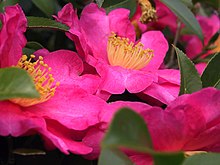| Camellia | |
|---|---|

| |
| Camellia sasanqua is used as a garden plant; its leaves are used for tea, and its seeds for oil | |
| Scientific classification | |
| Kingdom: | Plantae |
| Clade: | Tracheophytes |
| Clade: | Angiosperms |
| Clade: | Eudicots |
| Clade: | Asterids |
| Order: | Ericales |
| Family: | Theaceae |
| Genus: | Camellia L. |
| Species | |
|
About 187, see text | |
| Synonyms[1] | |
| |
Camellia (pronounced /kəˈmɛliə/[2] or /kəˈmiːliə/[3]) is a genus of flowering plants in the family Theaceae.[1] They are found in tropical and subtropical areas in eastern and southern Asia, from the Himalayas east to Japan and Indonesia. There are more than 220 described species.[1] Camellias are popular ornamental, tea, and woody-oil plants cultivated worldwide for centuries. Over 26,000 cultivars, with more than 51,000 cultivar names, including synonyms, have been registered or published.[4][5]
Of economic importance in East Asia, Southeast Asia, and the Indian subcontinent, leaves of C. sinensis are processed to create the popular beverage tea. The ornamental C. japonica, C. sasanqua and their hybrids are the source of hundreds of garden cultivars. C. oleifera produces tea seed oil, used in cooking and cosmetics.
- ^ a b c Cite error: The named reference
POWOwas invoked but never defined (see the help page). - ^ "camellia". Oxford English Dictionary (Online ed.). Oxford University Press. (Subscription or participating institution membership required.)
- ^ "camellia". Merriam-Webster.com Dictionary. Merriam-Webster.
- ^ Wang, Yanan; Zhuang, Huifu; Shen, Yunguang; Wang, Yuhua; Wang, Zhonglang (2021-01-19). "The Dataset of Camellia Cultivars Names in the World". Biodiversity Data Journal. 9: e61646. doi:10.3897/BDJ.9.e61646. ISSN 1314-2828. PMC 7838149. PMID 33519266.
- ^ "International Camellia Register-Camellia, Cultivars, Species, Photos". camellia.iflora.cn. Retrieved 2023-02-11.